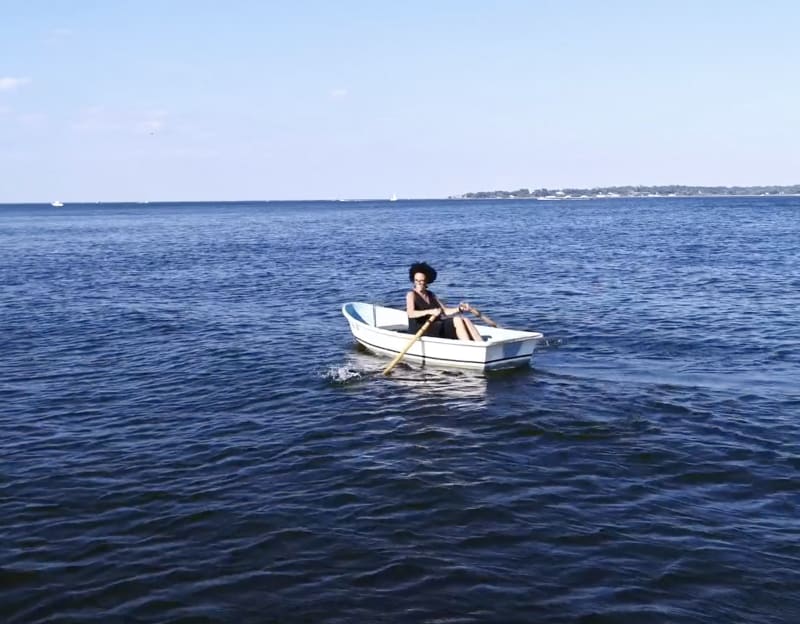Coco Fusco included in the group exhibition María Teresa Hincapié: Si este fuera un principio de infinito, curated by Claudia Segura and Emiliano Valdés at the Barcelona Museum of Contemporary Art in Barcelona, Spain.
The institution's press release follows:
María Teresa Hincapié: If this were a beginning of infinity is the first exhibition dedicated to the practice of María Teresa Hincapié (1954–2008), a Colombian artist specialising in what we might call ‘the poetics of everyday life’ in performance, transforming routine actions into symbolic acts to create a methodology in her practice. Hincapié had a unique definition of performance, which she called ‘training’. Eschewing any specific categorisation, her practice oscillated between life, creation in motion and a search for mysticism.
The exhibition reveals the importance of Hincapié's understanding of artistic creation as the necessary ephemeral and mutable conditions for a ‘search for the sacred’. Using the potential of affection as a mechanism of interaction with the late artist, the exhibition vindicates collective interaction as a producer of knowledge and an imperative vehicle of transmission.
In 1990, Hincapié received the First Prize at the XXXIII National Salon of Colombian Artists for her long-running performance Una cosa es una cosa (A thing is a thing). It was the first time that this prize had been awarded to an ephemeral, non-objectual work or to a woman. The action consisted of placing all the possessions from the artist’s house in the exhibition space. For eight continuous hours a day for several weeks, she dedicated herself to creating a dance with her body while reorganising the different elements according to changing criteria. She received this distinction again in 1996 with Divina Proporción (Divine Proportion), a performative work in which she spent several days living in the exhibition space, walking very slowly while sowing grass on the concrete floor.
Hincapié was born in Armenia, Colombia, and died at the age of 54 after a long illness. She became a key figure in the development of performance art during the 1980s and 1990s and was a thoughtful voice exploring bodily practices. Initially trained in theatre as a member of the Acto Latino group, she was influenced by the ideas of Jerzy Grotowski (1933–1999) and the experimental horizon that this Polish theatre director had opened around the concept of ‘poor theatre’, as well as by the explorations of Eugenio Barba, leading to Hincapié’s interest in a clean and simple dramaturgy.
In the mid-1980s, her practice took a decisive turn towards a greater inquiry into the performative, marking a seminal moment in the genesis of contemporary artistic practices in Colombia. The exploration of everyday life and the transformation of routine actions into symbolic acts created a methodology for her practice. Art became the raison d’être of her existence, not only providing a framework for her creativity but also influencing her ethics and understanding of politics. In 1995, she began her ambitious project Hacia lo sagrado (Towards the Sacred) with a walk from Bogotá to San Agustín, a journey that lasted twenty-one days, during which she combined her survival and ritual actions with a mystical thinking that, from that moment, became the core of her poetics.
Multiple questions arise when attempting to exhibit Hincapié’s work in a museum in order both to expose the importance of her practice and her new conception of the body and its context in the field of performance. How do you make this visible with archive documents, photographs, videos or works on paper? By wanting to include the physicality, gesture, stillness, silence, movement and presence that emanate from her work, while avoiding a re-enactment – to which she was completely opposed –, the exhibition María Teresa Hincapié: If this were a beginning of infinity at MAMM (16 March – 12 June 2022) and MACBA (20 October 2022 – 26 February 2023) involves combining new voices inspired by Hincapié’s practice.
Therefore, in this first exhibition dedicated to the work of the artist, a vast selection of her works will be presented: archive material from performances, photos, videos, written documentation, slides, visual testimonies, etc. Works created by José Alejandro Restrepo for Hincapié will also be included, as well as three projects commissioned specifically for the exhibition that open an essential debate on movement, bodies and the cognitive legacy of a practice that is itself destined for transformation. The artists and groups invited to develop a new work that dialogues with Hincapié’s performative language, with a praxis that is closely linked to that of the artist, are: María José Arjona (Colombia), Coco Fusco (Cuba) and Mapa Teatro (Colombia). In order to establish the potential of affection as a mechanism for interacting with the late artist, the underlying intention is to reproduce an attitude that Hincapié supported during her life and artistic career, and that is associated with the idea of sharing and creating a community. At the end of the nineties, she acquired some land (La Fruta) in the Sierra Nevada de Santa Marta where she created an artists’ residence that she called Aldea-escuela, a project that she kept going until her final days. Hincapié was convinced that living in a community was a way of producing knowledge and an essential vehicle for its transmission.

